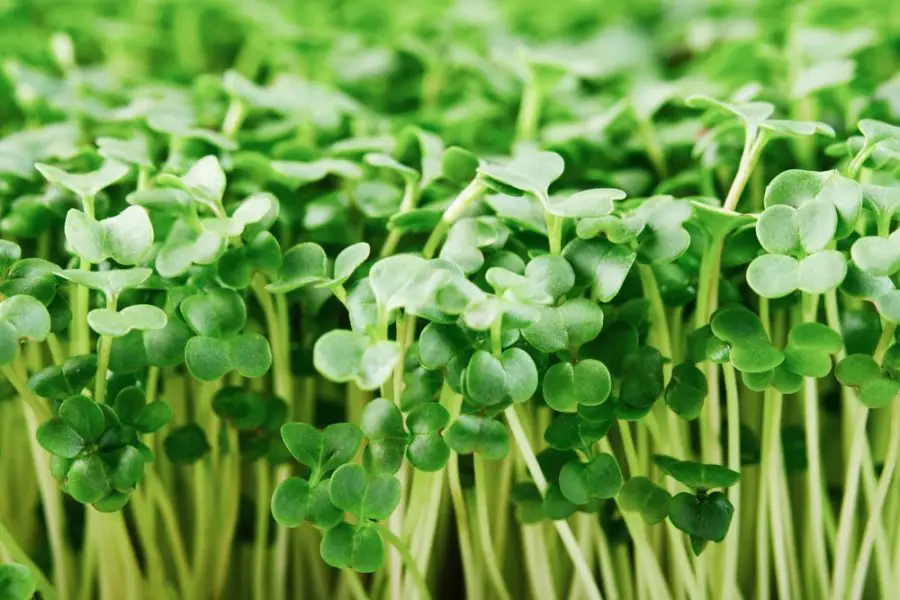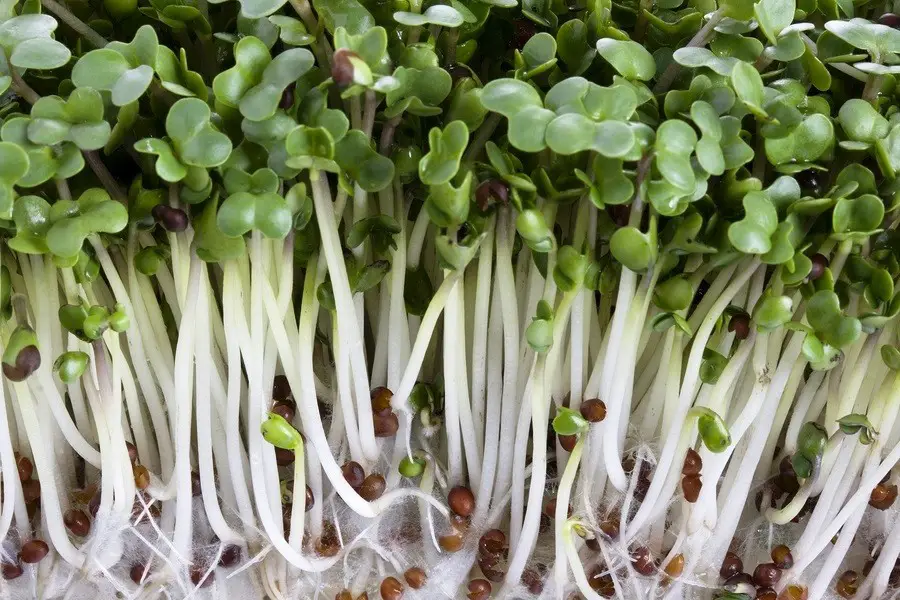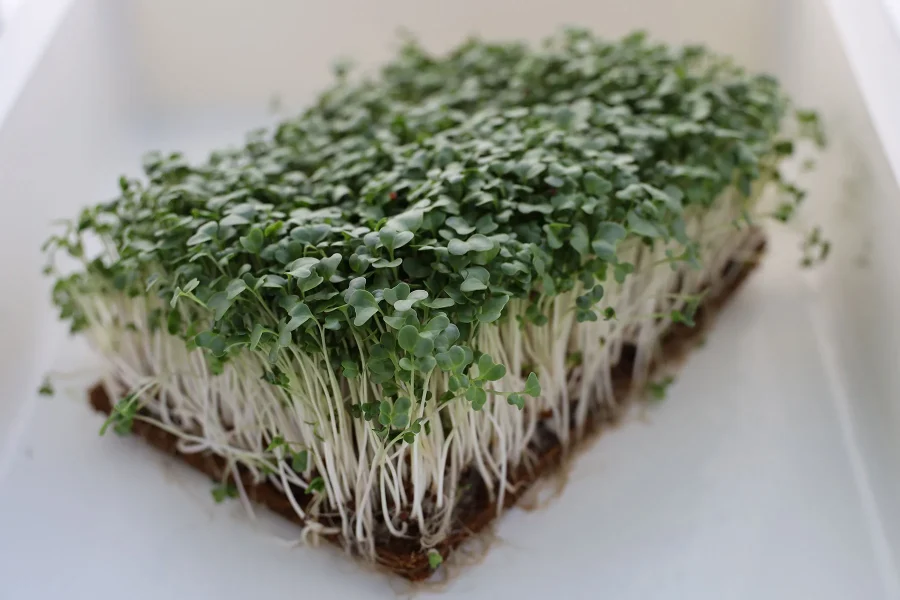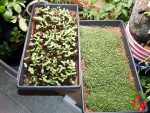This post contains affiliate links. If you buy something from one of our links we may earn a commission. Thanks

If you’re looking for an easy and fun way to get into gardening, consider growing broccoli microgreens at home.
Key Broccoli Microgreen Takeaways:
- Growing Broccoli Microgreens at home is a simple, cost-effective way to enhance your diet.
- All you need is a shallow tray, organic soil, broccoli seeds, and a sunny spot or a grow light.
- Sow the seeds, keep the soil moist with regular misting, and
- In about two weeks, you’ll have a nutritious harvest ready to be trimmed and added to your meals.
They’re a great source of nutrition, and they add a pop of color and flavor to any dish.
Plus, they’re really easy to grow and all you need is a sunny spot in your garden or kitchen window.
In this post, we’ll teach you how to grow broccoli microgreens using a few simple steps. We will touch on harvesting and storing microgreens and how to use them. Read on to learn more.
What Are Broccoli Microgreens And What Do They Taste Like?
Broccoli microgreens are tender young shoots of the broccoli plant. They are typically harvested when about 2 weeks old.
They have a mild flavor that is slightly sweet, tangy, and spicy flavor with hints of pepper, making them a great addition to many dishes.
Nutritionally, they are packed with essential vitamins and minerals such as vitamins A, C, E, and K.
Additionally, they contain powerful antioxidants that can help fight off free radicals in the body.
They are a great way to give your meals an extra nutritional boost and add flavor without overpowering the other ingredients.
Try adding them to salads, soups, smoothies, pizzas, and tacos. The possibilities are endless.

Are Broccoli Sprouts And Broccoli Microgreens The Same?
Sprouts and microgreens are not the same. A broccoli sprout is a young seed that you can sprout with water. Growing sprouts could eventually turn into microgreens in soil but are eaten in the sprout stage instead.
You can try growing broccoli sprouts in a mason jar and harvesting them right after germination. Growing sprouts is a different growing method entirely.
Broccoli microgreens are not grown in water like sprouts. They are grown in soil or on grow mats.
They are more mature broccoli plants that are starting to grow their first true leaves, typically at about 2 weeks from sprouting.
Because they actually have leaves that can photosynthesize they are higher in nutrition than sprouts.
What Are The Benefits Of Growing Broccoli Microgreens Indoors?
Growing broccoli microgreens at home have many benefits.
• It is more cost-effective than purchasing pre-grown greens from the store.
• It also ensures that your greens are free of contaminants, as you can choose the organic materials and growing environment.
• Additionally, it is much faster than growing full-sized plants – you can harvest in as little as two weeks.
• Additionally, it is much faster than growing full-sized plants – you can harvest in as little as two weeks.
• Finally it is ideal for urban gardeners because it is cheap to do, it’s easy to grow microgreens and they don’t take up a lot of space.

Nutritional Benefits Of Broccoli Microgreens
Eating broccoli microgreens regularly can provide many health benefits. Broccoli microgreens are an excellent source of essential vitamins and minerals such as vitamins A, C, E, and K.
They also contain powerful antioxidants that help fight off free radicals in the body. Additionally, they can help improve digestion, reduce inflammation, boost the immune system, and even help lower blood pressure.
Eating broccoli microgreens also provides a significant boost of energy and can help reduce cravings for unhealthy foods.
Microgreens are incredibly nutritious, as they contain high levels of vitamins and minerals. Eating them regularly can provide your body with essential nutrients and minerals that are necessary for a balanced diet.
Additionally, they are low in calories but still high in fiber, making them an excellent choice for anyone looking to add more nutrition to their meals without adding too many extra calories.
Enjoy all the benefits of broccoli microgreens—they’re sure to do your body good and with all these benefits, it’s no wonder why broccoli microgreens are becoming so popular!
Growing Broccoli Microgreens At Home In A Nutshell
Growing and harvesting your broccoli microgreens successfully doesn’t have to be difficult.
Here are a few tips that will help you get the best results:
Tips For Growing Broccoli Microgreens
• Start with a shallow tray and use quality, organic soil.
• Plant your broccoli microgreen seeds on the heavy side. You want a full tray.
•Press them into the soil or cover them lightly. Mist them after sowing. You can use a like-sized tray as a sprouting lid to cover them.
• Make sure to keep the soil evenly moist by misting it regularly.
• Harvest your greens as soon as they have reached the desired size, usually around two weeks.
• Use scissors or a sharp knife to cut the greens at the base of the stem.
• Immediately after harvesting, rinse them thoroughly and enjoy them.
By following these tips, you can be sure to have a successful harvest of delicious broccoli microgreens.
How To Grow Broccoli Microgreens At Home The Details
Growing broccoli microgreens at home are easy and cost-effective. You will need a shallow container, potting soil, broccoli seeds, and water.
You may need to use a grow light in the winter if you want to grow microgreens year-round.
Microgreen Seed
You don’t need a special variety of broccoli microgreens seed to grow microgreens.
Any broccoli seeds will be just fine. But make sure they have not been treated with anything so it is best to buy non-GMO and organic broccoli seeds.
Some people recommend soaking seeds before planting. It’s OK for large seeds like peas or sunflowers.
But it makes evenly sowing small seeds like broccoli very difficult. So I prefer to sow dry seeds on a moist surface and then misting them regularly.
Containers
Fill your container with potting soil, sprinkle the broccoli seeds evenly over the surface of the soil, then lightly mist them with water to moisten the soil.
You should start to see sprouting seeds in less than a week.
 I use 1020 seedling trays to grow my microgreens but any recycled shallow food container can work as long as it is clean.
I use 1020 seedling trays to grow my microgreens but any recycled shallow food container can work as long as it is clean.
If you water carefully by misting regularly you won’t need to have drain holes in your container.
Soil
You can use potting soil or coco coir as your soil. Coco will give better results than peat or peat-based growing medium. It is also a more sustainable environmental choice.
 Learn how to grow broccoli microgreens without soil by using jute or coco grow mats. After soaking a growing mat you simply plant seeds on top and mist them.
Learn how to grow broccoli microgreens without soil by using jute or coco grow mats. After soaking a growing mat you simply plant seeds on top and mist them.
Cover with a paper towel or another tray until seeds sprout and then remove any cover.
Light
Broccoli microgreens require a lot of light to grow properly. In the summer a windowsill might work ok if you rotate the tray.
Broccoli microgreens need at least 4-6 hours of direct sunlight to grow properly. Without enough light, plants will etiolate which means they get leggy and can fall over.
The amount of natural daylight will depend on where you live; in the northern hemisphere, during summer months there are typically up to 15 hours of daylight whereas in winter months this is reduced to less than 8 hours and it is often cloudy.
You want to grow healthy leaves and not just long stems so make sure you have enough light.
Be sure to check your local climatic conditions before deciding on when to begin growing your broccoli microgreens.
In most parts of the US, during the winter months, there will not be enough natural light so you will need supplemental lighting.
LEDs or fluorescent grow lights should be used once germination occurs.
If you don’t want to use supplemental lighting you will be limiting yourself to only growing microgreens half the year.
How To Harvest Your Homegrown Broccoli Microgreens
Once the broccoli microgreens have reached 2-3 inches in height, they are ready for harvesting.
To harvest, simply trim off the shoots with scissors at the base of the stem. You can also use a sharp knife but I think scissors work better.
The harvested microgreens can be used fresh in salads, sandwiches, and wraps, blended into smoothies, or juiced. They also make a great garnish for soups and other dishes.
You want to use your microgreens as soon after harvest as possible. While you can keep them in the fridge for about a week taste and nutritional value will be less than fresh micro greens.
How To Store Broccoli Microgreens
To store broccoli microgreens, wrap them in a damp paper towel and place them in an airtight container or plastic bag. Store in the refrigerator for up to a week.
You can freeze microgreens but the texture and color will change. While it is best to use microgreens fresh they can be frozen.
Freezing will rupture the plant cells so taste, texture, and consistency will not be the same. Still, you can use them in smoothies or stir-fries.
More Tips For Growing Broccoli Microgreens At Home
For growing broccoli microgreens successfully, it is important to give them enough light and water.
Place your container in an area with direct sunlight or under fluorescent lights, and be sure to keep the soil moist but not soggy.
It is important to use soil that drains well; if your soil is too compact or dense, it can lead to root rot and poor germination.
Additionally, you might want to use a high-quality fertilizer to give your broccoli microgreens the essential nutrients they need.
Adding fertilizer can help ensure they get the most out of their growing environment.
It is important to water your broccoli microgreens regularly, as this will encourage healthy growth. Using a mister is a great way to water microgreens and can help eliminate overwatering.
The amount and frequency of watering will depend on the size and type of container you are using, as well as the humidity in your climate.
Be sure to check your microgreen trays regularly and adjust your watering schedule accordingly.
If growing on a windowsill make sure to rotate your tray every day so that all sides of the plants get equal exposure to light.
It’s also important to harvest your greens within two weeks of planting when they reach two to three inches in length, as longer-term growth can decrease the nutrient content and lead to a bitter taste.
Store your harvested microgreens in an airtight container or plastic bag in the refrigerator to keep them fresh for up to a week.
What To Do With Leftover Broccoli Microgreens After Harvesting?
Once you’ve harvested your broccoli microgreens, there are plenty of delicious ways to use them in the kitchen!
You can add them to salads for a flavorful crunch, toss them into soups and stews, or blend them up into smoothies.
They also make a great topping for pizzas and tacos. Additionally, you can dry or freeze your leftovers to enjoy later.
By freezing them, you’ll be able to maintain their freshness and flavor for up to a year.
So don’t let those delicious broccoli microgreens go to waste – get creative in the kitchen and find new ways to enjoy them.
What Are Some Creative Ways To Use Broccoli Microgreens?
Broccoli microgreens are incredibly versatile and can be used in a variety of dishes. They make a great addition to salads, soups, omelets, sandwiches, and wraps.
You can also use them as a topping for pizza or combine them with other microgreens like arugula or radish to create an interesting and flavorful side dish.
They also make a great garnish for any meal and can even be used to add texture and flavor to smoothies or juices.
With so many creative ways to use broccoli microgreens, the possibilities are endless.
What Are Some Of The Best Ways To Store Broccoli Microgreens?
The best way to store broccoli microgreens is to wrap them in damp paper towels or a damp cloth and keep them in an airtight container or plastic bag in the refrigerator. This will ensure that they stay fresh and crisp for up to a week.
If you are not planning on eating them right away, you can also freeze them to extend their shelf life even further.
Just make sure to thaw them out before consuming them. With these storage tips, you’ll be sure to enjoy your broccoli microgreens for a long time to come.
How To Incorporate Broccoli Microgreens Into Your Meals?
There are so many delicious ways to incorporate broccoli microgreens into your meals. They make a great addition to salads, soups, smoothies, sandwiches, and even tacos.
You can also try adding them to pizzas for an extra flavor boost or topping them on avocado toast for an extra nutritional kick.
Using different herbs and spices is a great way to add flavor and interest to your broccoli microgreens.
Try adding some freshly chopped thyme, basil, or parsley for a herbal twist. You can also sprinkle them with chili peppers or garlic powder for a hint of spice.
Get Creative With Flavor When Eating Broccoli Microgreens
For an exotic touch, try adding some ground cumin or curry powder. Whatever flavors you choose to use, adding them to your broccoli microgreens is sure to take your meals up a notch.
If you don’t want to cook with them, you can also enjoy them as a snack – just grab a handful and munch away. They are low in calories and a good snack for diets.
So whatever your preference, there is sure to be an option that will make your taste buds happy.
Recipes That Include Broccoli Microgreens
I am not a chef but if you look online you should be able to find lots of recipes that use microgreens.
For a simple and delicious side dish, try adding broccoli microgreens to your favorite stir-fry recipe.
Or for something that’s sure to impress, you can create a salad with roasted beetroot, walnuts, and goat cheese topped with a light vinaigrette dressing and some tasty broccoli microgreens.
You can also try making a tasty pesto by blending together broccoli microgreens, olive oil, fresh garlic, pine nuts, and parmesan cheese.
Whichever way you choose to use them, adding broccoli microgreens to your recipes is sure to take them up a notch.
FAQs
Embarking on the journey of growing Broccoli Microgreens indoors is a step towards a healthful lifestyle.
The tender greens not only add a nutritional punch but also a burst of flavor to your dishes.
As you venture into this green endeavor, you might have a plethora of questions.
Here’s a handy FAQ to guide you through the process, addressing common queries from the setup to the harvest, and making the most of your homegrown Broccoli Microgreens.
Will broccoli microgreens grow into broccoli?
Because of the number of plants and limited amounts of soil and nutrients they will be very unlikely to live long enough to form heads.
Do broccoli microgreens regrow after harvesting?
Most microgreens will not be able to grow back. Once they are cut they no longer have side buds that can regrow. Generally growing microgreens is a once-and-done crop.
Can you use regular broccoli seeds for microgreens?
Yes, you can use regular broccoli seeds if they are untreated with any chemicals and are not bird seed which is sterilized.
Do broccoli microgreens taste like broccoli?
Broccoli microgreens are just baby vegetables that are harvested long before they produce broccoli heads so they will not taste exactly like mature broccoli.
Can you eat microgreens every day?
You can eat microgreens every day and at least a cup of vegetables a day is a healthy amount.
Can you grow broccoli microgreens without soil?
Yes, you can grow many types of microgreens with grow mats instead of using soil. Grow mats also make harvesting cleaner and less messy.
Can you use regular potting soil for microgreens?
You can use regular potting soil for microgreens as long as it is not too heavy. Use coco coir instead if you can. It is lighter and environmentally friendly.
How much sulforaphane do broccoli sprouts have?
Broccoli sprouts have 100-400 times the amount of sulforaphane as compared to other cruciferous vegetables.
Sulforaphane is a sulfur-rich compound found in cruciferous vegetables like broccoli, bok choy, and cabbage. It has been shown to provide powerful health benefits.Sulforaphane: Benefits, Side Effects, and Food Sources (healthline.com)
How often do you water broccoli microgreens?
You want to keep them moist but not wet. You can mist them once or twice a day depending on temperature and humidity.
How can you make broccoli sprouts more digestible?
You could try cooking them before eating.
How long do broccoli microgreens take to grow?
You should be ready to harvest about 2 weeks after germination when their true leaves start to show.
Do you need lots of light to grow microgreens?
They require at least 4-6 hours of direct sunlight or they will get leggy. You may need supplemental lighting in the winter.
Do you want drain holes in microgreens?
You don’t need drain holes if you water correctly. I recommend misting instead of directly watering the tray.
Do you need a fan for microgreens?
Microgreens require good airflow so if they are in a spot where airflow is stagnant a fan will help. Lack of airflow can result in mold growth.
Do microgreens need to be washed?
It is a good idea to wash them so they are free from any soil after harvesting them. But you want to pat them dry on a paper towel before storing them in a container in the fridge.
What happens if you let microgreens keep growing?
There will not be enough room, soil, or nutrients in a tray to mature properly. They will be stunted or may even die. If you want larger plants try growing baby greens instead with more soil and space between plants.
What is the difference between microgreens and sprouts?
Sprouts are grown in water and are freshly germinated seeds. They are mostly roots with undeveloped leaves. Microgreens are sprouts grown in soil that are allowed to mature and grow some leaves.
Do you have to keep buying seeds for microgreens?
Unfortunately yes. Microgreens are harvested once and are not large enough to make seeds. Consider sowing trays in succession for a steady supply.
What is the white fuzz that looks like mold?
It probably is mold. Limed air flow and too much moisture is the cause. Using a dome can cut off airflow and cause mold. Sterilize your trays, don’t overwater, and make sure they have good airflow.
Can you reuse the soil after harvesting microgreens?
You really should not reuse the soil as it may cause disease in your next crop. Potting soil should never be reused. Coco could possibly be reused if you sterilize it in a hot oven.
Can you use tap water for microgreens?
Tap water can vary greatly but generally, you can use city water for microgreens although some plants may be sensitive to chlorine or other chemicals in the water.
Why are your micro greens falling over?
If your plants are not getting enough light they will get leggy (etiolate) and fall over. Get them in an area with more light or use a grow light.
Can you survive on only microgreens?
I doubt it. You need more than just vitamins. You need protein to grow and repair your body. It is rare if not impossible for any one thing to be a complete food.
How many hours of led light do microgreens need?
It depends on the light but I would go for at least 12 hours of light. Don’t give them more than 16-18 hours of light.
What are the disadvantages of microgreens?
The only real disadvantages are that you will always need to buy seed and the seeds are only good for one crop.
Is it cheaper to grow or buy microgreens?
It is much cheaper to grow your own microgreens. They will also be fresher and more nutritious.





